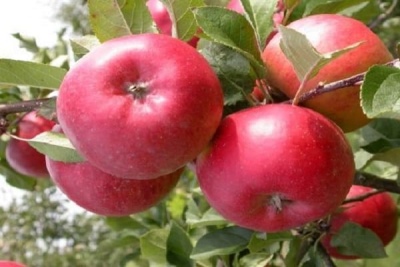
- Authors: Purdue University (USA)
- Taste: sour sweet
- Scent: present
- Fruit weight, g: 150-200
- Fruit size: large
- Yield: 40-60 kg per tree
- The beginning of fruiting varieties: for 2-3 years
- Ripening terms: late winter
- Removable maturity: late September - mid-October
- Keeping quality: in the refrigerator until March - April
Any gardener dreams of good fruit trees on their own plot. Apple trees are no exception, especially since they are available for almost all regions of our country, up to the northern ones. Apple-tree Enterprise is a fast-growing representative of winter categories. An unpretentious plant easily tolerates low temperatures, is rich in vitamins, has good transportability and early maturity. Synonym for Enterprise.
Breeding history of the variety
The tree was bred in America, the authorship belongs to the University of Purdue. The Enterprise is the result of many years of selection work and crossing of the Malus floribunda 821 hybrid, which is the carrier of the Vf gene, and the varieties Golden Delicious, Starkrimson, Mekintosh, Rum Beauty.
Description of the variety
Enterprise is a medium-sized tree with a wide-rounded fluffy crown. The branches are covered with light green foliage, blooms with medium-sized white flowers.
Features, pros and cons
This variety has many positive qualities, thanks to which its seedlings are in constant demand in nurseries.
Pros:
stable yield;
excellent transportability;
good health and disease resistance;
the ability to long-term storage of fruits without losing their commercial qualities;
palatability improves with storage time, and the plant is unpretentious.
The disadvantages are the inability to self-pollinate, that is, other varieties with the same flowering period will be needed in the garden.
Ripening and fruiting
The Enterprise seedling begins to bear fruit 2-3 years after planting, then the crop is harvested every year, if everything is in order with the health of the plant. Fruits reach removable maturity in the last decade of September - early October, therefore the plant is classified as late winter.
Growing regions
Good frost resistance allows the cultivar to be grown in all horticultural regions. In subtropical climates, additional watering will be needed.
Yield
Mature trees give a stable yield of tasty and beautiful fruits - 40-60 kg per tree, which is a very good indicator for cold regions.
Fruits and their taste
Bright red barrel-shaped apples (rounded-flattened) reach 150-200 grams. The yellow-creamy juicy pulp has a dense fine-grained structure, a sour-sweet taste and is covered with a thick shiny, as if varnished, smooth skin. The apple has a pronounced aroma and can be stored in cool conditions and appropriate humidity until March-April.

Growing features
For landing, they choose sunny places with protection from cold northerly winds. The apple tree is unpretentious to soils, but most of all loves slightly acidic soils. The distance when planting is 1–1.5 meters between the pits. Landing is done in a standard way, giving preference to spring. In cold regions, autumn planting is not always justified.During the summer season, young seedlings will have time to get stronger, build up a healthy root system and go under the snow ready for wintering. When choosing a location, one must remember about groundwater. They should not come close to the roots of an adult plant.
A drainage layer is arranged in the pits, the excavated soil is enriched with organic matter and mineral fertilizers - humus, superphosphate, potassium sulfate. In the first 2 years, feeding is not needed, the introduction of nutrients in subsequent years is mandatory. The trunks are weeded and loosened without touching the roots, saturating the soil with oxygen. Watering is carried out once every 14 days in the absence of precipitation. Sanitary pruning is also necessary, as is thinning the thickened crown. In spring and autumn, dry, diseased branches are removed, excess shoots are cut out. Formative pruning not only gives the crown a well-groomed appearance, but also helps to increase the yield, rejuvenates the shoots.



Pollination
This is a non-self-fertile variety, so there should be suitable apple trees nearby: Fuji, Elstar, Florina and others that coincide in flowering time. If the flight of bees and bumblebees is not observed, pollination is carried out on their own.

Frost resistance
Enterprise is known for its frost resistance, it tolerates harsh winters well. If winter temperatures drop to -35 degrees and below, then the trunks are mulched and covered with agrofibre.

Diseases and pests
The tree is highly resistant to scab, monilial burn, powdery mildew, rust and pests. However, preventive spring and autumn treatments with insecticides and fungicides are required.

The apple tree is a popular fruit crop among gardeners. It can be found in many summer cottages. But at the same time, such trees are often affected by various diseases. It is very important to recognize the disease in time and carry out the necessary procedures for a speedy recovery. Otherwise, the fruits will be spoiled, and the tree itself may die altogether.












































































